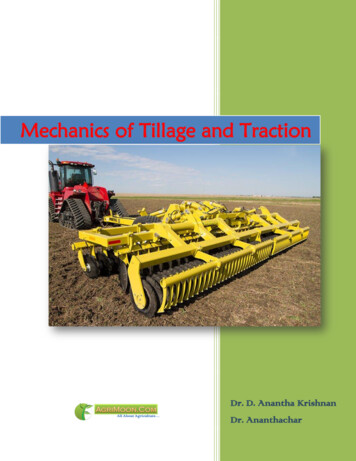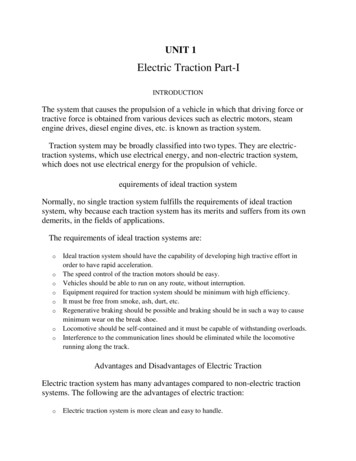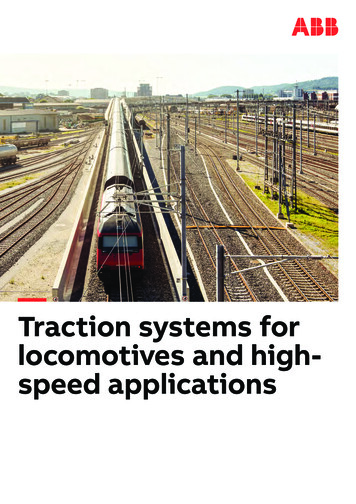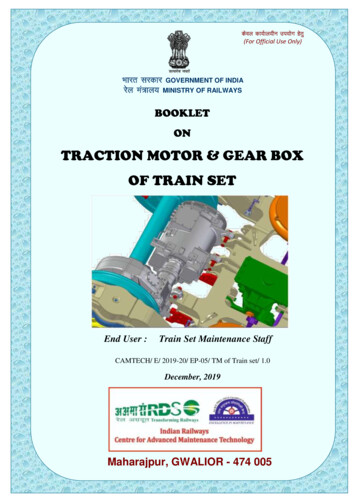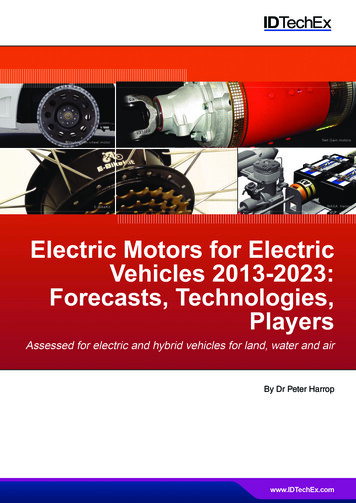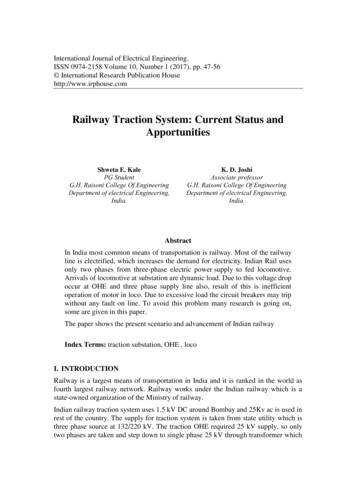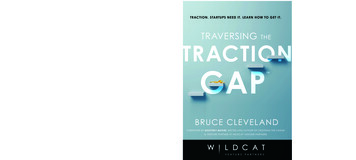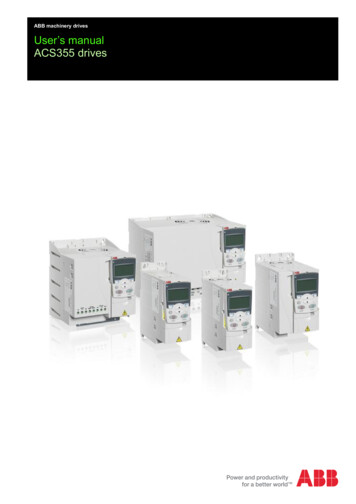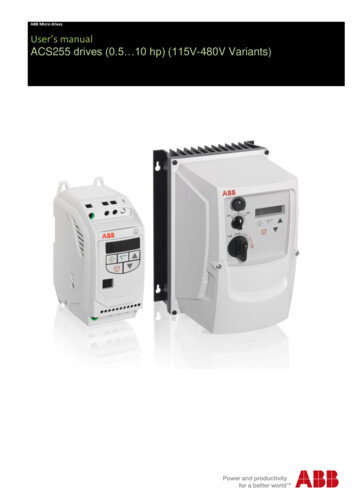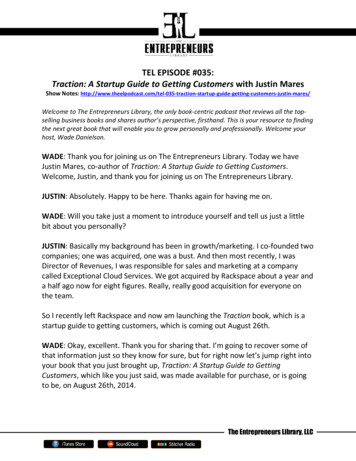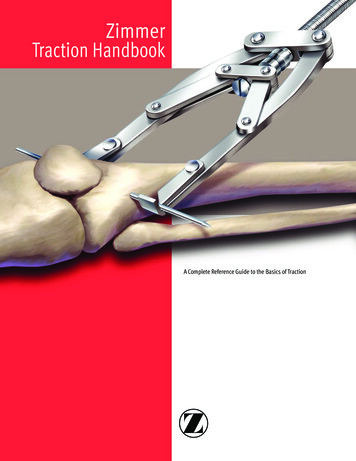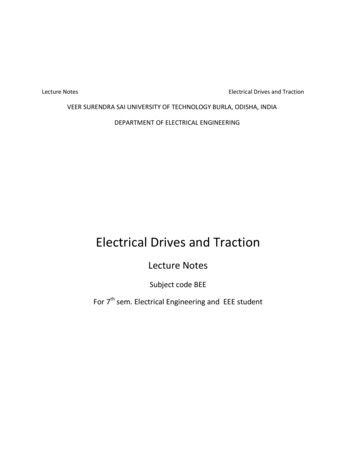
Transcription
Lecture NotesElectrical Drives and TractionVEER SURENDRA SAI UNIVERSITY OF TECHNOLOGY BURLA, ODISHA, INDIADEPARTMENT OF ELECTRICAL ENGINEERINGElectrical Drives and TractionLecture NotesSubject code BEEFor 7th sem. Electrical Engineering and EEE student
DISCLAIMERCOPYRIGHT IS NOT RESERVED BY AUTHORS. AUTHORS ARE NOT RESPONSIBLEFOR ANY LEGAL ISSUES ARISING OUT OF ANY COPYRIGHT DEMANDS AND/ORREPRINT ISSUES CONTAINED IN THIS MATERIALS. THIS IS NOT MEANT FOR ANYCOMMERCIAL PURPOSE & ONLY MEANT FOR PERSONAL USE OF STUDENTSFOLLOWING SYLLABUS. READERS ARE REQUESTED TO SEND ANY TYPINGERRORS CONTAINED, HEREIN.
Veer Surendra Sai University of Technology, Odisha, Burla, IndiaDepartment of Electrical Engineering,(7th SEMESTER)ELECTRICAL DRIVES AND TRACTION (3-1-0)(For Electrical and Electrical & Electronics Engineering Students)MODULE-I (10 HOURS)Requirements, AC and DC drives, modern trends in drives technology, Characteristics of DC,Induction and Synchronous motor drives, (starting, running, speed control, braking), size andrating of motors (short time, intermittent, continuous), Mechanical considerations (enclosure,bearing transmission of drive, through chain, pulley and gears noise) .MODULE-II (10 HOURS)Control for drive systems, Control of D.C, Induction, and Synchronous motor drives. ControlTechniques for electric drives, Block diagram representation, transfer functions, transientresponse, frequency response and stability, compensating techniques.MODULE-III (10 HOURS)Electric Traction: System of electric traction Mechanics of Train Movement: Speed- time,distance- time and simplified speed-time curves, Attractive effort for acceleration andpropulsion, effective weight, train resistance, adhesive weight, specific energy output andconsumption.Traction Motors: Review of characteristics of different types of DC and AC motors used tractionand their suitabilityMODULE-IV (10 HOURS)Rating and heating of electric drives, power loss, Heating and cooling of motors, Classes andduty and selection of motors, Drives for specific application like steel, paper, Textile Millscontrol of electric drives microprocessor hardware and software for drive system.REFERENCE BOOKS[1] V.Subrahmanyam, “Electric Drives” , TMH publication[2] M.H.Rashid , “Power Electronics” , P.H.I. Edition[3] G.K.Dubey, “Electric Drive”, Norasa Pub. House ND[4] Austin Hughes, “Electrical motors and drives, Fundamental, Types and Application” Newnespublication[5] S.K.Pillai , “A First Course on Electrical Drives”,2nd Edition, John Wiley & Sons
MODEL QUESTION-1TIME: 3 HoursFM: 70Answer any Six questions including Q.No.1 which is compulsory.1.Answer all the following questions.(a)(b)(c)(d)(e)(f)(g)(h)(i)(j)[2 10]Write four advantage of an electric drive system.Draw the typical torque-speed characteristics of mechanical loads.What is a Group Electric Drive (Shaft Drive)?What is meant by “load equalization?Why stator voltage control is more suitable for speed control of induction motor in fan type loadthan constant type load ?A train driven by separately excited dc motors has better co-efficient of adhesion than driven byseries motor. Justify the statement.Compare static Kramer and Scherbius drive system.Draw the simplified speed/time curve for the main line services and show all necessary periods.What is self control of synchronous motor ?A 440 V, 60 Hz induction motor is to be used on a 50 Hz supply. What voltage should be used?2. a) Why flywheel is mounted on the shaft of the motor in non-reversible drive? Deduce the expressionfor the Moment of Inertia of the flywheel.[4]b) A motor has a heating time constant of 45 minutes and coolingtime constant of 75 minutes.The motor has final steady state temperature rise of 500C while delivering its continuous rating of 25kWi) Determine the load the motor can deliver for 15 minutes so that the temperature rise does notexceed 500C.ii) The motor delivers 35 kW for a period of 15 minutes followed by a shutdown for 15 minutes.Determine the maximum temperature lectricalbrakingbriefly.b) A 220 V, 1500 rpm, 11.6 A separately excited motor is controlled by a l-phase fully-controlledrectifier with an ac source voltage of 230 V, 50 Hz. Enough filter inductance is added to ensurecontinuous conduction for any torque greater than 25 percent of rated torque, Ra 2 ohmi) What should be the value of the firing angle to get the rated torque at 1000 rpm?ii) Ca1culate the firing angle for the rated braking torque and - 1500 rpm.iii)Ca1culate the motor speed at the rated torque and 160o for the regenerative braking in the secondquadrant.[4 6]4. a) Explain with sketch how the rheostatic braking is done in D.C. shunt and series motors[4]
b) The switching frequency of the chopper is 2 kHz. The source voltage is 80V and the duty ratio is 30%.The load resistance is 4 ohm. Assume that the inductance and capacitance are ideal and large enough tosustain the load current and load voltage with little ripple. Calculatei) On time and switching periodii) Average voltage across the loadiii) Average current of the load[6]5.a) Formulate the expression for the tractive effort during acceleration period of a locomotive train.b) Explain the speed control of induction motor by stator voltage/hertz control method.[5 5]6.a) The distance between two stations is 1.92kms.The scheduled speed and the duration of stopsrespectively are 40kmph and 20sec. Assume the quadrilateral approximation of the speed-time curveand the coasting and braking retardation as 0.16kmphps and 3.2kmphps respectively. Determine theacceleration if the speed at the end of the accelerating period is 60.8kmph.Find also the duration of thecoasting period.[6]b) Sketch and explain the static Kramer’s variable speed drive system[4]7. a) How the operation of synchronous motor shifts from motoring to generative braking ?b) Draw the speed-torque characteristics of a three phase induction motor in its 4-quadrant region.[5 5]8.Write short notes on the following (Any two)[5x2]a) Steady state stability of an electric driveb) Static Ward-Leonard Drive Systemc) Speed control by D.C. Chopper
MODEL QUESTION-2TIME: 3 HoursFM: 70Answer any Six questions including Q.No.1 which is compulsory.1.Answer all the following questions.[2 10]a) Differentiate between the active and passive load related to drive system.b)Draw the torque-speed characteristics of a separately excited DC motor during dynamic braking.c)Why regenerative braking is not possible in half controlled rectifier ?d)What are methods to reduce the energy loss during starting of three phase induction motor ?e)What is the limitation for static Kramer drive and how it will be improved ?f)Differentiate between the CSI and VSI .g)Why stator voltage control is more suitable for speed control of induction motor in fantype load than constant type load ?What is meant by “load equalization?h)What is function of pantograph in electric locomotive train A train driven by separately exciteddc motors has better co-efficient of adhesion than driven by series motor. Justify the statement.i)A train driven by separately excited dc motors has better co-efficient of adhesion thandriven by series motor. Justify the statement. Draw the simplified speed/time curve for the main2.line services and show all necessary periods.j)What are merits and demerits of microprocessor based drive system ?a) Derive the thermal modelling for heating and cooling curve ?b) A motor has a heating time constant of 90 minutes. If the temperature rise of the motor is1000 C when it is continuously loaded with its rated load. Determine the temperature rise ofthe motor after 2 hour of its rated load. If the temperature after 2 hour reaches the maximumpermissible temperature (final steady state temperature with rated load appliedcontinuously) after it is overloaded, determine the permissible overloading ? Assumeconstant loss 0.5 of full load copper loss.3. a) Draw the circuit diagram and briefly explain the dynamic braking of a three phase inductionmotor.[3]b) Plot and briefly explain the torque-speed characteristics of dc shunt motor during regenerativebraking.[3]c) Explain the speed control of three phase induction motor by rotor injection method.[4]4. a)Why braking is required ? Explain each of the electrical braking briefly.[4]
b)A 2200V,50 Hz, three phase,6 pole ,Y- connected squirrel cage Induction motor has followingparameters.Rs 0.075 , Rr' 0.12 X s X r' 0.5 The combined inertia of motor and load is 100 kg-mt2. Calculatei)The time taken and energy dissipated in the motor during starting.ii)The time taken and energy dissipated in the motor when it is stopped by plugging.[6]5.a) Formulate the expression for the tractive effort during acceleration period of a locomotive train.b) Explain the speed control of induction motor by stator voltage/hertz control method.[5 5]6.a) The distance between two stations is 1.92kms.The scheduled speed and the duration of stopsrespectively are 40kmph and 20sec. Assume the quadrilateral approximation of the speed-time curve andthe coasting and braking retardation as 0.16kmphps and 3.2kmphps respectively. Determine theacceleration if the speed at the end of the accelerating period is 60.8kmph.Find also the duration of thecoasting period.b) Sketch and explain the static Kramer’s variable speed drive system[6 4]7. a) How the operation of synchronous motor shifts from motoring to generative braking ?b) Draw the speed-torque characteristics of a three phase induction motor in its 4-quadrant region. [5 5]8. Write short notes on the following (Any two)a) Steady state stability of an electric driveb) Static Ward-Leonard Drive Systemc) Speed control by D.C. Chopper[5x2]
MODEL QUESTION-3TIME: 3 HoursFM: 70Answer any Six questions including Q.No.1 which is compulsory.1.Answer all the following questions.[2 10]a)State the advantages of the electric drive?b)How electric friction is necessary for drive ?c)Chopper control drive have more advantages over phase controlled drive. Justify.d)What are the advantages of V/f methods for speed control of induction motor ?e)For good adhesion, the motor speed-torque characteristics should have low speed regulation andfor good load sharing of loads between motors, the torque-speed curve should have high regulation,Why ?f)Mention some of the drawback of conventional Ward-Leonard scheme over static Ward-Leonardscheme.g)What are the advantages of single phase,25KV,50 hz transmission line for locomotive train.h)Draw the speed-torque characteristics of a three phase induction motor in its 4-quadrant region.i)Why regenerative braking is not preferred for dc series motor ?j)Plot the torque-speed characteristics of dc shunt motor during dynamic braking.2.a) Derive the formula for overloading factor, when a motor is subjected to i) short time dutyii) intermittent periodic duty.b) Derive the transfer function of an armature controlled dc motor and draw the closed loopblock diagram.[5 5]3. a) What are the various factors that influence the choice of electric drives ?[4]b) A 230V,960 rpm and 200 amp separately excited dc motor has an armature resistance of 0.02ohm. The motor is fed from a chopper which provides both motoring and braking operations.The source has a voltage of 230V. Assuming continuous conductioni) Calculate duty ratio of chopper for motoring operation at rated torque and 350 rpm.ii) Calculate duty ratio of chopper for braking operation at rated torque and 350rpm.iii) If the duty ratio of chopper is limited to 0.95 and the maximum permissible motor currentis twice the rated, calculate maximum permissible motor speed and power fed to the source?4.a) A 150 V, dc shunt motor drives a constant torque load at a speed of 1200 rpm. The armatureand field resistances are 1 ohm and 150 ohm respectively. The motor draws a line current of 10amp at the given load. Calculate i) the resistance that should be added to the armature circuit to
reduce the speed by 50%. ii)Assume the rotational losses to be 100W,Calculate the efficiency ofthe motor without and with the added resistance.[6]b)Draw and explain the various torque-speed characteristics of three phase induction motor atbelow and above base frequency.[4]5.a) A 2.8 kW,400V,50hz,4 pole,1370rpm delta connected squirrel cage induction motor hasfollowing parameters referred to the stator.Rs 2 Rr' 5 X s X r' 5 X m 80 . Motor speed is controlled by stator voltagecontrol. When driving a fan load it runs at rated speed at rated voltage. Calculate i) motorterminal voltage, current and torque at 1200 rpm ii) motor speed, current and for the terminalvoltage of 300 V.b) With neat diagram describe the static Kramer’s method for slip recovery power for three-phase induction motor. What are the drawbacks seen.[5 5]6. a) A train service consists of following uniform acceleration of 1kmphps for 2 minutes. Freerunning for 30 minutes. Coasting for 2 minutes at a deceleration of 0.1kmphps. Uniform brakingat 1.2 kmphps to stop the train. Stopping time 5 minutes. Calculate i) Distance between thestations ii) The scheduled speed[6]b) Describe the duty cycle of main line service of the traction drive.[4]7. a) Draw and explain the phasor diagram of synchronous motor operating with constant loadtorque at different value of rotor excitation.[5]b) Explain the speed control of three phase induction motor by rotor emf injection method.8. Write short notes on the following (Any two)a)Load equalizationb)Tractive effort for train movementc)Drive mechanism in textile mill[5x2]
MODULE-1INTRODUCTION TO DRIVE SYSTEMSDrives: Systems employed for motion control are called drives. Motion control is required in industrialas well as domestic applications like transportation system, rolling mills, paper mills, textile mills,machine tools, fans, pumps, robots, washing machines etc. Motion control may be translational, rotationalor combination of both. Generally, a drive system is basically has a mechanical load, a transmissionsystem and a prime mover. The prime mover may be I.C. engine, steam engine, turbine or electric motors.However, electric motors are predominantly used employed as prime mover due to certain advantages.Advantages of Electric Drives: Flexible control characteristics. Starting and braking is easy and simple Provides a wide range of torques over a wide range of speeds (both ac and dc motor) Availability of wide range of electric power Works to almost any type of environmental conditions No exhaust gases emitted Capable of operating in all 4 quadrants of torque –speed plane Can be started and accelerated at very short timeChoice of Electrical Drives:The choice of an electrical drive depends on a number of factors. Some important factors are: Steady state operation requirements: (nature of speed-torque characteristics, speed regulation,speed range, efficiency, duty cycle, quadrants of operation, speed fluctuations, rating etc) Transient operation requirement(values of acceleration and deceleration, starting, braking, speedreversing) Requirement of sources:(types of source, its capacity, magnitude of voltage, power factor,harmonics etc) Capital and running cost, maintenance needs, life periods Space and weight restrictions Environment and location Reliability
Basic Elements of the Electric Drive Systems:Fig 1.1A modern electric drive system has five main functional blocks as shown above a mechanical load, amotor, a power modulator, a power source and a controller.Power source: The power source provides the energy to the drive system. It may be dc or ac (singlephase or three-phase)Power Converter: The converter interfaces the motor with the power source and provides the motor withadjustable voltage, current and frequency. During transient period such as starting, braking and speedreversal, it restricts source and motor current within permissible limits Also the converter converts theelectric waveform into required signal that requires the motor.Types of modulator: Controlled Rectifier(ac to dc) Inverter (dc to ac AC Voltage Regulator (ac to ac DC Chopper (dc to dc) Cyclo-converter (ac to ac) (Frequency converter)Controller:A well designed controller has several functions. The basic function is to monitor system variables,compare them with desire values, and then adjust the converter output until the system achives a desiredperformance. This feature is used in speed and position control.Electric motor: i) The basic criterion in selecting an electric motor for a given drive application is itmeets power level and performance required by the load during steady state and dynamic operation.ii) Environmental factors: In industry such as in food processing, chemical industries and aviation wherethe environment must be clean and free from arc. Induction motors are used instead of DC motor.Mechanical Load:The mechanical load usually called as machinery such as flow rates in pump, fans, robots, machine tools,trains and drills are coupled with motor shaft.Classification of Load torque: Various load torques are broadly classified into two categories.A) Active Load Torque
B) Passive Load TorqueLoad torques which have the potential to drive the motor under equilibrium conditions are called activeload torques. Such load torques usually retain their sign when the direction of the drive rotation ischanged. Torque due to the force of gravity, hoists, lifts or elevators and locomotive trains also torquesdue to tension, compression, and torsion undergone by an elastic body come under this category.Components of the Load Torque (TL) :The load torque TL can be further divided into the following components:1.Friction torque TF: The friction will be present at the motor shaft and also in the various parts of theload.2.Windage torque TW: When a motor runs, the wind generates a torque opposing the motion. This isknown as the windage torque.3.Torque required to do the useful mechanical work, TM: The nature of this torque depends on the type ofload. It may be constant and independent of speed, it may be some function of speed, it may be timeinvariant or time variant, and its nature may also vary with the change in the load's mode of operation.The friction torque ‘TF’ can be resolved into three components as shown in figure 1.2b.Fig 1.2 (a)Fig 1.2 (b)TF TV TC TS( 1.1)The first component Tv which varies linearly with speed is called viscous friction and is given by thefollowing equation:TV Bwm(1.2)where B is the viscous friction coefficient.The windage torque Tw , which is proportional to speed squared, is given by the following equation:Tw Cwm2where C is a constant.So, TF TV is taken in account.Now, the load torque can be represented by TL TM TV Tw(1.3)
TL TM Bwm Cwm2(1.4)In many applications Tw Cwm2 is very small compared to Bwm and negligible compared to TM . Tosimplify the analysis, the term Tw is neglected.TL TM Bww(1.5)Torque-Speed Characteristics of Mechanical Load:Fundamental Torque EquationsMechanical load exhibit wide variations of speed-torque characteristics. Load torques are generally speeddependent and can be represented by an empirical formula such as nT CTr nr k(1.6)Where C is a proportionally constant,Tr is the load torque at the rated speed nr, n is the operating speed ,and k is an exponential coefficient representing the torque dependency speed. Figure shows the typicalmechanical loads.1.Torque independent of speed.The characteristics of this type of mechanical load are represented by setting k is equal to zero and Cequals to 1.While torque is independent of speed. Such examples are hoists,the pumping of water etc.2. Torque linearly dependent on speed. The torque is linearly proportional to speed k 1,and themechanical power is proportional to the square of the speed. An example would be a motor driving a dcgenerator connected to a fixed resistance load with constant field. It can be shown asT Pwhere P is the power generated by generatorw(1.7)
P k 2 w2 k 2 wBut P VI and T wRwR(1.8) T w(1.9)3. Torque proportional to the square of speed.The torque-speed characteristic is parabolic, k 2. Such examples of loads are fans, centrifugal pumps,and propellers.T w2(1.10)4. Torque inversely proportional to speed.In this case, k -1.Examples are milling, boring machines, road vehicle and traction etc. T 1w(1.11)Combined torque-speed characteristics of Motor-Load system:Speed-torque characteristics of motor and mechanical loadDynamic of Motor-Load System:Fundamental Torque EquationsThe dynamic relations applicable to all types of motors and loads. The dynamic or transient condition.These condition appears during starting, braking and speed reversal of the drive.A motor generally drives a load (machine) through some transmission system. While the motor alwaysrotates, the load may rotate or may undergo a translational motion. It is convenient, however, to representthe motor load system by an equivalent rotational system, as shown in figure .The following notations is adapted:J polar moment of inertia of the motor-load system referred to the motor shaft,Kg-m2wm instantaneous angular velocity of the motor shaft, rad/ secTm developed torque of the motor, N-mTL the load (resisting) torque, referred to the motor shaft, N-mAny motor-load system can be described by the following fundamental torque equation during dynamiccondition:
Tm TL Tm TL Jd( Jwm )dtdwmdJ wmdtdt(1.12)(1.13)This equation is applicable for variable inertia drives such as mines winder, industrial robots etc.And Tm TL Jdwmdt(1.14)This equation is for constant inertia i.e.dJ 0dtnegative sign for deceleration and positive sign for acceleration.Acceleration or deceleration depends on whether Tm is greater or less than TL .During acceleration,motor should supply not only load torque TL but also an additional torque component called inertia torquedwmdwmto overcome the drive inertia. During deceleration, dynamic torque Jhas negative sign.dtdtTherefore, it assists the motor torque Tm and maintains drive motion by extracting from stored kineticJenergy.The fundamental torque equation balance between the various torques in the drive may be consideredwhile investing the dynamic behavior isdwmdt(1.15)TL TM Bww(1.16)Tm TL JWhere,It is seen from the above equation that, whenTm TLi)dwm 0dti.e.(1.17)the drive will be accelerating, in particular, picking up speed to reach rated speedii)Tm TLi.e.dwm 0dt(1.18)the drive will be decelerating and particularly, coming to restiii)Tm TLdwm 0i.e. dt(1.19)the motor will continue to run the same speed, if it were running or will continue to be at rest,if it were not running.Stability:Steady State StabilityA) Transient state Stability or Dynamic StabilityCriteria for Steady State Stability:Let us assume that the motor-load speed-torque curve is at in equilibrium i.e. at steady state.
The disturbances changes the equilibrium states. The disturbances are two types. Such as1.Due to slow change of inertia of rotating masses or that of inductances changes the equilibrium statesslowly. So, effect of the inertia and the inductances are neglected for dynamics.2. Due to large and sudden changes of inertia and inductances there is a sudden changes of equilibriumstates. So, the inertia and inductances are taken for dynamic study.Study of stability under conditions given above for the first type of disturbance relate to the field of steadystate stability while for the second type of disturbance pertain to the field of dynamic or transientstability.Let the equilibrium values of the torques and speed be denoted by Tm , TL and wmThen at equilibrium, when deviation is not occurredTm TL(1.20)Let a small deviation in load torque is done, so that all equilibrium changes by Tm , TL and wmdwmd ( wm wm )becomes Tm Tm TL TL Jdtdtthen, the dynamics Tm TL J Tm TL Jd wmdt(1.21)(1.22)If we assume that these increments are so small that may be expressed as linear functions of the change inspeed, then Tm dTL wmdwm TL WheredTmdwmanddTLdwmdTm wmdww(1.23)(1.24)indicates derivatives at the point of equilibrium.Sybstituting theserelations in early equation and rearranging, we haveJd wm dTL dTm wm 0 dt dwm dwm wm wm 0 e t (1.25)J dTL dTm dwm dwm called mechanical time constant.For the system to be stable when the exponent of the equation be negative. This exponent will be negativewhendTL dTm 0dwm dwm(1.26)
dTL dTm dwm dwmor(1.27)Transient state stability:Concept of Transient StabilityThus the equation of motion in terms of power, can be written asPm Pdyn PLWhere Pm , Pdyn(1.28)and PL denote the motor power, dynamic power and the load power at the shaftrespectively. The dynamic power is determined from the angular acceleration. Let the angularposition of the shaft at any instant is taken as the between a point and reference which isrotating at synchronous speed. With sudden application of load, since the rotor slows down, theangular acceleration will be negative and hence the dynamic power will be given byPdynd 2 Pj 2dt(1.29)Where, Pj J * w *2Poles(1.30)The electromagnetic power Pm has two components (i) damping power which linearly varies withd dtfrom synchronous speed and (ii) Synchronous power which is a function of load angle . Thus,d 2 d Pj 2 Pd P( ) PLdtdt(1.31)Where, Pd is the damping power. Neglecting damping and assuming cylindrical rotor, then the aboveequation will bePjd 2 Pm sin PLdt 2Where, Pm Now,(1.32)VEXsd 2 PL Pm sin dt 2Pjd , we havedtd 2 d PL Pm sin d dtdt 2 dt Pj Mul;tiplying both sides by(1.33)
2 PL Pm sin d Pj0 d dt (1.34)Where 0 is the load angle before the disturbance, i.e., at time t 0. So, for the machine to be stable at thesynchronous speedd 0 . Hence,dt2 PL Pm sin d 0Pj0 (PL(1.35) Pm sin )d .(1.36) 0With the motor initial load PL1 , the operating point is at A corresponding to point 0 . As the load issuddenly increased to PL 2 , the power angle swings to f at which the speed is again synchronous. When ithe system is stable P Pm sin d L2 0 f PL2 Pm sin d 0 i(1.37)where i is the power angle corresponding to new load PL 2 . So, from the equation it is to be written as i P L2 Pm sin d 0 f P msin PL 2 d (1.38)iOr Area A1 A2 . This method of determining the transient stability of a drive system is called equal areacriterion of stability.Conclusion :i)If area A1 A2 , the drive is stableii)If area A1 A2 , the drive is just stableiii)If A1 A2 , the motor loses synchronismRating of Motor:From the classes of duty the motor rating is selected. A motor can be selected for a given class of dutybased on its thermal rating with due consideration to pull out torque i.e. the overload must be within thepull out torque. The various classes of duties are Continuous duty
Intermittent duty Short time dutyContinuous duty: Two classes of continuous duty are there. a) continuous duty at constant load b)continuous duty with variable loadi)continuous duty at constant load: It denotes the motor operation at a constant load torquefor a long duration enough to attain the steady state temperature. Ex. Paper mill drives,centrifugal pumps and fans etc. Frequent starting is not required. The rating of themachine is decided by input power.If efficiency of the load and transmission is ,the input power to the load isP wT(for rotational body) (1.39)T load torqueP F *V0.201* (for linear motion)(1.40)F force exerted by load in kgV velocity of motion in m/secP F *V2 * 0.102 * P HQ 0.102 * (for elevator)(for pump)(1.41)(1.42)H gross head comprising suction in mtQ quantity of delivery of pump in mt 3/sec density of liquid in kg/mt 3P HQ0.102 * (for fan)(1.43)Q volume of air in mt 3/secH pressure of air in kg/mt 2ii)continuous duty with variable load: Load has several steps in one cycle. The motor rating isneither selected for highest load nor lowest load rather the rating is selected on average losses for theload cycle. Ex. Metal cutting lathes, conveyors etc.For variable motor mechanical load, the current to the motor is variable. To find the rating of the motorthe equivalent current Ieq method is used for finding the motor rating.
Let each step of the load the power loss is composed of constant loss which is independent of load calledcore and variable loss called copper loss. The variable load consists of motor current I1,I2 .I6 for onecycle.ThusPc I eq2 R I eq ( Pc I12 R)t1 ( Pc I 22 R)t2 . ( Pc I 62 R)t6t1 t2 . t6I12t1 I 22t2 .I 62t6t1 t2 t3 . t6(1.44)After Ieq is determined, a motor with next higher current rating ( Irated) from commercially availableratings is selected.DC motor: For the design of dc motor, the maximum allowable current is 2 times the rated current.Induction and Synchronous motor: Here the maximum breakdown torque to rated is 2 to 2.25Short Time Duty: In short time duty, the time of operation is less than the heating time constant and themotor is allowed to cool down to the ambient temperature before it is required to start again. If a motorrating of power Pr is subjected to short time duty load of Pr , then the temperature rise will be far belowthan the permissible temperature per . Therefore, the motor can be overloaded by a factor K 1 such that,the maximum temperature rise just reaches the permissible value per .Now, for the load KPr ,the time ofoperation is t r . tr per ss (1 e ) ss per 1 1 e tr (1.45) For motor power Pr the loss is P1rFor power KPr , the loss is P1s , then ss P1s per P1r 1 1 eBut, P1r Pc Pcu and let KPthen, P1s Pc Pcu r Pr tr PcPcu2 Pc K 2 Pcu Pcu ( K 2 ) (1.46)
From the equations, the overloading factor1 K
A 2200V,50 Hz, three phase,6 pole ,Yb) - connected squirrel cage Induction motor has following parameters. R s:0.075: , ' 0.12 R r ' 0.5: s X r The combined inertia of motor and load is 100 kg-mt2. Calculate i)The time taken and energy dissipated in the motor during starting. ii)The time taken and energy dissipated in the motor when it is .
